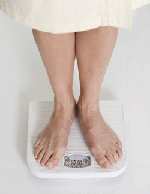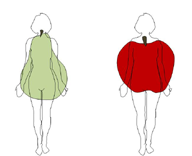There is no scientific evidence that menopause or hormone therapy is responsible for midlife weight gain.
Many women gain weight during the menopause transition. This weight gain is sometimes blamed on menopause or on treatment for conditions related to menopause, including hormone therapy. However, there is no scientific evidence that menopause or hormone therapy is responsible for midlife weight gain.
 Age and lifestyle are the main culprits. Aging and lifestyle seem to be the primary culprits behind weight gain in women around the time of menopause. Aging is associated with slowing of the metabolism. Lean body mass decreases with age while body fat accumulates throughout adulthood. The bottom line: you have to “run to stay in place.”
Age and lifestyle are the main culprits. Aging and lifestyle seem to be the primary culprits behind weight gain in women around the time of menopause. Aging is associated with slowing of the metabolism. Lean body mass decreases with age while body fat accumulates throughout adulthood. The bottom line: you have to “run to stay in place.”
Women generally become less physically active as they pass through their 40s, 50s, and 60s. Let’s face it: at any age, burning fewer calories because we are less active increases weight and fat mass. With decreased activity, muscle mass decreases.
 Does menopause affect body shape? Although menopause may not be directly associated with weight gain, it may be related to changes in body composition and fat distribution. Several studies have shown that perimenopause, independent of age, is associated with increased fat in the abdomen as well as decreased lean body mass. This suggests that menopause plays a role in many midlife women’s transition from a pear-shaped body (wide hips and thighs, with more weight below the waist) to an apple-shaped body (wide waist and belly, with more weight above the waist) (see figure). However, further study is needed on the exact role of menopause in body composition.
Does menopause affect body shape? Although menopause may not be directly associated with weight gain, it may be related to changes in body composition and fat distribution. Several studies have shown that perimenopause, independent of age, is associated with increased fat in the abdomen as well as decreased lean body mass. This suggests that menopause plays a role in many midlife women’s transition from a pear-shaped body (wide hips and thighs, with more weight below the waist) to an apple-shaped body (wide waist and belly, with more weight above the waist) (see figure). However, further study is needed on the exact role of menopause in body composition.
| |  | Menopause is thought to play a role in many women’s midlife transition from a pear-shaped body to a more apple-shaped body. |
Regardless of the different contributions of aging and menopause to weight gain and body composition, the fact is that most women in North America are overweight at midlife. Any excess weight raises the risk of many diseases, including cardiovascular disease (which is particularly linked with excess fat in the abdomen), type 2 diabetes, high blood pressure, osteoarthritis, and some types of cancer (including breast and colon). Beyond their clear effect on a woman’s overall health, these conditions tend to compromise her sexual function through reduced energy, reduced mobility, poor self-image, and other factors.